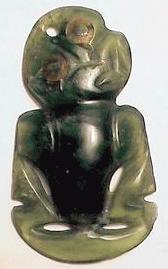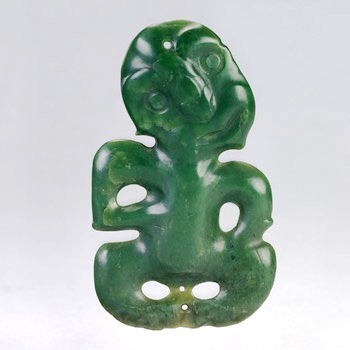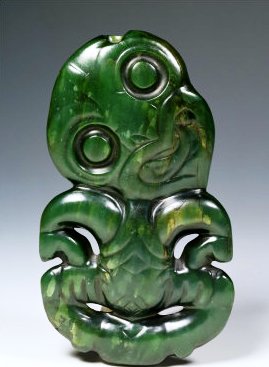Difference between revisions of "Tiki"
(→Illustrations) |
(→Illustrations) |
||
| Line 23: | Line 23: | ||
| − | <table border="1" cellspacing="1" > | + | <table border="1" cellspacing="1" width="100%"> |
<tr> | <tr> | ||
Revision as of 15:23, 12 January 2012
Contents
Heitiki
Tiki or heitiki are traditional ornaments created by Maori, the Polynesian first settlers of New Zealand. The material they are most commonly made from is nephrite, a stone related to jade, found in several places in New Zealand's South Island. It is called pounamu in Maori, greenstone in common New Zealand English. The Maori name for the South Island, Te Wai Pounamu, refers to the stone. There are traditional accounts for the creation of the stone which relate it to the children of Tangaroa. It is a very hard stone and is laborious to work, especially so with the basic grinding tools available to the Neolithic Maori. The ornament is unique to New Zealand, as are several other ornaments made from this stone.
Wkipedia has a page on heitiki.You can see some portraits of 19th century Maori wearing tiki here.
The stone is both hard and tough and made good edge tools. Adzes and chisels made from the material were prestige items. They are not commonly found in ancient sites. In many years of participation in archaeological excavations I have personally excavated two small nephrite chisels. No doubt as a prestige items they were carefully preserved rather than put at risk of loss. As a tough stone breakages would be rare so the common method of artefacts getting into sites - of being discarded - would also be rare. So the rarity of adzes and chisels in sites does not necessarily mean they were rare in use - simply that they were conserved.
It is also a beautiful stone - classed as semi-precious - and quite variable as to this character within and between sources (e.g.) The varieties have Maori names. However it is not an easy stone to source from a hand sample. Its lustre improves with age reputedly as a result of being worn next to the skin. A recent book about Pounamu is by Beck and Mason[1]
Tiki were worn around the neck - the hei part of the name carries this implication. They are more often, but not exclusively, worn by women in recent times. Suspension is usually vertical but some are suspended on their side. Some traditional tiki in bone and ivory exist, made from whale bone or teeth, but as bone tiki are now commonly made for commercial trade, a bone tiki found in a shop is more likely to be recent and of cow bone. Most tiki are one sided but a few are reversible showing a figure on both faces.
Illustrations
Te Papa's online illustrations of its tiki collection can be seen here.
Tiki in some other New Zealand museums can be seen here
Some USA museum tiki collections can be seen here.
The name tiki (penis) is one which is applied to stone statues elsewhere in Polynesia. It is the name of a male demigod which appears often in Polynesian mythology and is unquestionably ancient. The symbology of Maori tiki has been much debated[2]. They are thought of by some as fertility symbols, but strangely given their name, the detail of many of them shows female reproductive organs. One theory interprets detail on tiki as representing common birth deformities (club foot etc.) and suggests they are a talisman to protect against such things[3].
The Maori have occupied New Zealand since about 1100 AD. The historical origins of tiki are not understood as they are virtually absent from the archaeological record. For a precious item this is not surprising. Few would have been lost or discarded. Conventionally though they are associated with the later part of New Zealand's prehistory, as nephrite is uncommon in early sites. They were certainly in use at the time of the first contact with Europeans. Some individual tiki have names and traditional histories extending well back into the pre-European past. Others have renewed suspension perforations replacing worn through old ones, showing they have seen much use over a long time.
Sites of manufacture of nephrite tools and ornaments have been found on the east coast of the South Island. However the tools and ornaments were much used in the North Island where most of the population lived. Trade / exchange of the material clearly then occurred to create this distribution. The trade appears not to have been all in finished goods for there are regional styles of nephrite ornaments in the North Island[4] which suggest that some at least of the manufacture was local, either from raw material or re-manufacture from other items.
There is some variety in the forms of tiki - this variation has not been very fully studied as to its differentiation by region. The head inclined left or right appears to have no particular significance. One clear variation is between those with the head upright and those with it tilted sideways. The likely explanation for the latter form is that is was to ease the re-manufacture of rectangular planform adzes into tiki[5] The availability of iron axes and adzes made nephrite adzes redundant in the early 19th century and allowed this recycling of the nephrite material. Adzes part way in the process of re-manufacture as tiki are known and sometimes on completed tiki, traces of the original cutting end shaping of a adze can be seen, usually at the foot. Other variations occur in the positions of the arms. In some the arms are asymmetric with one arm on the torso rather than the legs, or up to the mouth.
The eyes are often infilled with red sealing wax of European origin. This does not mean the tiki is a more recent one as wax was added to the eyes of older tiki. Some have paua (N.Z. abalone) shell eyes.
The arrival of 19th century technology allowed a major burst of commercial manufacture of tiki mainly for a New Zealand market. Many supposedly old tiki date from the late 19th century and reveal themselves through details such as the suspension perforation being straight sided. Some nephrite ornaments were gold mounted in the 19th century. Again this does not necessarily indicate the nephrite ornament was of that date.
Value
Tiki remain prestige items in New Zealand today; heirlooms in Maori families and occasionally in Pakeha (non-Maori) ones as well. They are worn by Maori on ceremonial occasions and occasionally by Pakeha too where they have acquired them through some historical event. Sometimes they are ceremonially displayed rather than worn. Not all of these tiki are ancient. Some are 19th century commercial ones.
Old tiki are vigorously competed for in New Zealand auctions and command high prices.
This tiki sold in an eBay Internet auction in 1999 for US$1,500.00  And this made US$990, again on eBay, in 2001.
And this made US$990, again on eBay, in 2001. 
Most New Zealand museums have good collections of tiki. The major ones have larger collections than they can display. Competition for then usually is for private rather than public ownership. They may come with the suspension cord complete with a bone toggle. This should be left intact, as should wax applied to the eyes. Cleaning should not involve abrasives. Those with suspension cord need to be stored away from light and protected from damp and insects. It is illegal to export old ones from New Zealand without a permit.
Presentations
They were items of presentation in traditional Maori society, being associated with events such as marriages. They are items of presentation in very important modern state occasions. For instance the settlement of the Ngai Tahu tribal claim was marked by a ceremony which included the presentation of Maori treasures, including a tiki, by the Prime Minister. Royal visits are another occasion. National leaders visiting Auckland in 1999 for the APEC conference were each presented with a modern greenstone item at the formal welcome. Presentations of traditional items from Maori can have a "string attached" in that the eventual return of the tiki to the presenter's tribe is expected, so that the item does not become absolute personal property. Maori have taken offence, many decades after such a "gift", when it has come on the market to be sold and have sought to reclaim the item.
Other Traditional Pounamu Items
Other traditional nephrite items include:
heimatau - fish-hook shaped pendants.
ear pendants - some re-manufactured from chisels.
pekapeka - a Northland form of pendant.
adze (toki) blades.
ceremonial adze blades.
chisels.
mere - clubs.
pet kaka (parrot) leg rings.
A lot of other forms occur in more recent jewellery.
Modern Manufacture
Tiki are still made today, particularly for the tourist trade. Some are from Asia, made from other than New Zealand nephrite but sold as if they were such in New Zealand. Most are smaller than the traditional sizes. Few achieve the art of the traditional tiki, but there are exceptions. Some fine heimatau are made today, not always in traditional style. These can be found in better craft and tourist shops and advertised on some Internet web sites.
Export of the raw stone has long been banned. Today pounamu sources have been returned to their traditional owners, the Ngai Tahu tribal group. For information on their intentions visit their webpage.
External Resources
Tiki Page http://www.lawas.co.nz/LINKS/tikipage.htm
Otago Museum http://www.otagomuseum.govt.nz/pounamu_new_zealand_greenstone.html
New Zealand Mineral Resources http://www.nzpam.govt.nz/cms/pdf-library/minerals/publications/fact-sheets/CO11916_7_Pounamu.pdf
References
- ↑ Russell Beck with Maika Mason. 2010.Pounamu: the jade of New Zealand. Penguin in association with Te Rūnanga o Ngāi Tahu
- ↑ Skinner, H.D. 1966 (2nd edition) The Maori hei-tiki Otago Museum
- ↑ Charles O. Bechtol 1967 Hei-Tiki Journal of the Polynesian Society 76(4):445 - 452
- ↑ Law G. 1980 "Regional Variation in Maori Greenstone Pendants of the Kuru Style." Records of the Auckland Institute and Museum. 16:63-75.
- ↑ L. M. Groube, Note on the Hei-Tiki. 1967 Journal of the Polynesian Society 76(4): 453 - 458.


